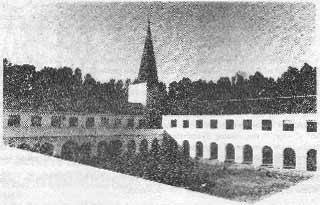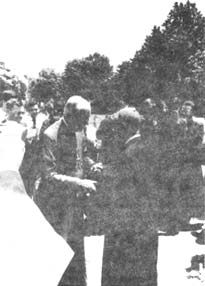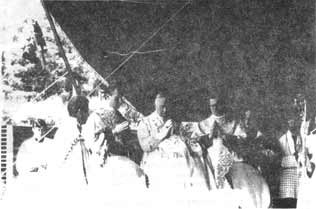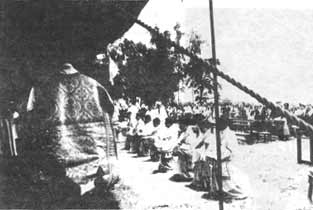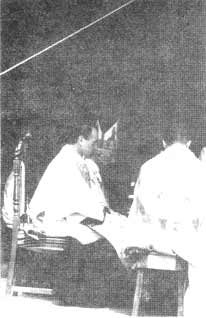Ordinations in Argentina
The cloister and central yard of Our Lady Coredemptrix Seminary in La Reja, Argentina, looking across to the bell tower.
"AN EIGHTIETH BIRTHDAY! I don't know what anyone sees in my eightieth birthday! Some people even wished me eighty years more! But maybe we should leave such things in the hands of God."
Archbishop Lefebvre almost didn't make it to the celebration with which everyone at the seminary at La Reja was waiting to honor him. The airline personnel were on strike. And our dear Sisters, who had gone to so much trouble, not only over the dinner, but also over a magnificent cake featuring His Grace's coat of arms—including the famous motto Credidimus caritati—were anxiously wondering if the results of their efforts would hold up under the delay. At least the seminarians took advantage of the extra time for more rehearsals of the music they had composed for the occasion.
Then suddenly everything fell into place. Early on the afternoon of November 29, word went round the seminary: "The Archbishop is coming! The Archbishop is coming! He's here!"
Since last spring, and during his travels, the Archbishop had said to one person and another how important he considered the ordinations which he was to perform in Argentina early in December. For the first time, eight deacons, trained entirely at the seminary of Our Lady Coredemptrix at La Reja, located about forty miles from Buenos Aires, would be ordained priests.
Now the Archbishop had expressed the wish to see other priests and some of the laity come with him to Argentina, to give to the faithful, to the professors and especially to the young seminarians, a show of support, a reassurance that the Society is a great family, united in God, even if its members are scattered over the entire world.
"Don't get too involved with airline connections," warned the Archbishop. "Charter flights are less trouble . . ."
"This sort of thing looks fine on paper, but in reality it is quite another matter."
Then, as they say in the military, an operation was launched under a code name—"The Archbishop's Wish"—by international headquarters in Rickenbach. So many headaches! So many struggles! So many setbacks in planning! But the thanklessness of preparations for such a journey were more than compensated by its success.
How easy to picture the radiant smile of the Archbishop as he steps out of the car in front of the main door of the seminary and is immediately surrounded by all the seminarians, all the priests of the Society and friends from other countries, all who have made the trip from Europe.
First of all, of course, there is Father Schmidberger, Superior General of the Society, who has just come back from Australia and India. Father Paul Aulagnier, Superior of the District of France, is also on hand. "Well!" says the Archbishop with a mischievous smile. "You finally succeeded in jumping the traces and getting out of France!" There is Father Joseph Bisig, Superior of the seminary at Zeitzkofen (West Germany); Father Richard Williamson, Superior of the seminary at Ridgefield (United States); Father Denis Roch, Superior of the District of Switzerland; Father Edward Black, Superior of the District of Great Britain; Father Patrick Groche, our representative in French-speaking black Africa; Canon Porta, an army chaplain from Versailles; Father Dominique Lagneau, representing the seminary at Ecône; Father Pierre Epiney, the famous Curé de Riddes.
"Oh," says the Archbishop, "I must greet Father Nöel, the father of us all!" Everyone rightly guesses that he means Father Andre, head of the Association Nöel Pinot, an organization for all priests who wish to remain faithful to the Mass of their ordination. And of course Father Alfonso de Galarreta, Superior of the District of Argentina; and Father Andres Morello, Superior of the seminary, are present, along with the entire faculty.
The Archbishop has cordial greetings for the friends who have come from Switzerland and from France, leaving the gray skies of Europe to take part in "The Archbishop's Wish" by going to the other end of the earth—"upside down" as Father Aulagnier jokingly remarked. Here it is summer. The flowers are blooming. It is the month of Our Lady. . . and in three weeks it will be Christmas!
Yes indeed, the Archbishop will very soon receive his most beautiful birthday gift. "The Archbishop's Wish" will be fulfilled beyond even his own expectations.
Seven Deacons and Four Subdeacons
The first ceremony to take place in the seminary chapel is the ordination by Archbishop Lefebvre of four subdeacons and seven deacons, trained entirely at the seminary at La Reja.
A beautiful statue of the Blessed Virgin is set up on the gospel side, with a great mantle of dark blue velvet edged in silver, enveloping her like a cape—the sort of thing one sees in Holy Week processions in Spain, a crown on her head and on her chest a golden heart pierced by swords. Inside this was placed a paper containing all the names of the priests, the faculty, the seminarians and also the Sisters in the convent about a hundred miles from the seminary.
With the same fervor, the same recollection, the same emotions that everyone feels when kneeling before the Archbishop, eleven young men prostrate themselves during the chanting of the Litany of the Saints, crossing forever the line dividing the world from the service of God.
Bishop de Castro Mayer Arrives
During the late afternoon, word goes round the cloisters and corridors of the seminary: "Bishop de Castro Mayer is here. . ." Here was the reunion of two former comrades in arms, in rear action skirmishes at the Council (not one of the documents of which was signed by the courageous Brazilian bishop). The two of them had sent an "Open Letter to the Pope" on November 21, 1983, a letter which has yet to be honored with a reply.
In fact, the arrival of His Excellency Bishop Antonio de Castro Mayer meant the reunion of two bishops faithful to their priesthood, to the immemorial Mass, to their apostolic mission, to the tradition of the Church, to the Catholic Faith—reunited in circumstances beyond what either of them could have imagined or hoped for.
Archbishop Lefebvre greets and welcomes His Excellency Mgr. de Castro Mayer, arriving at the Seminary from Brazil on November 30, 1985, to attend first ordinations to the priesthood at the seminary in Argentina.
Eight New Priests
Finally the great day arrives. It is Sunday, December 1, the First Sunday of Advent, the beginning of the liturgical year—a symbolic beginning mentioned by the Archbishop in his sermon. The ordination of the first eight priests trained entirely at La Reja is beginning.
† † †
In the calendar year 1985, Archbishop Lefebvre ordained thirty priests for the Society of St. Pius X, combining groups from Ridgefield, Ecône, Zeitzkofen and Canada, not counting priests belonging to other communities.
As Father Franz Schmidberger says, "I suffer a great sadness every day when I think that, if the 3,000 bishops of the world would do what Archbishop Lefebvre is doing, not only would the Church be saved, but the entire world would be Christianized, or re-Christianized."
Of course the seminary chapel is too small, and here as elsewhere, access to churches and a fortiori to our cathedrals being refused us, the ceremony takes place out of doors. For days, everyone has been occupied in preparing a magnificent altar under the protection of Our Lady Coredemptrix, covered by a tent, as at Ecône, and for the faithful the cathedral dome will be the dome of heaven, toward which the eucalyptus trees lift their leafy arms.
Now everyone watches for the arrival of the procession, which emerges slowly from the large door of the seminary and (as at Ecône and Zeitzkofen) continues toward the clearing, where nearly a thousand faithful are gathered, some from distant countries, with our nuns in the front row on the epistle side.
All eyes are on Archbishop Lefebvre, bringing up the rear of this magnificent procession of priests and seminarians, but everyone looks also to see Bishop de Castro Mayer. This is cause for great joy: at last to see another bishop, a true bishop, in the vestments of a bishop, in procession with the deacons. Canon Porta, wearing a biretta topped with a great violet pompon walks alongside them. A third bishop? No, just a canon. But Archbishop Lefebvre told him he would make a good bishop, and he seemed pleased.
The ceremony begins, in the way familiar to those who go faithfully every year to Ecône. As at Ecône, the weather is radiant, the clouds have vanished . . . and as at Ecône, there will be some sunburns.
Before proceeding to the ordinations according to the traditional rite, Archbishop Lefebvre addresses the priests, the seminarians and the faithful:
We have good reason to rejoice. This ceremony will be recorded in the history of the seminary of La Reja. It is, in fact, the first time that eight deacons, educated entirely at the seminary, will receive priestly ordination, and we hope that generations of priests will go out from this seminary each year for the greater good of the Church.
Let us note also that Providence has accorded us a special blessing in the presence of His Excellency Bishop de Castro Mayer.
Your Excellency, we thank you profoundly for your presence here today with us. It is a milestone in the history of the fight we have been waging since the Council. The Good Lord has given us, as brothers in the episcopate, the grace to understand that something happened at the Council and after the Council, which was not according to the will of God, which was not according to the Holy Ghost, which was not according to the Tradition of the Church. At the time of the Council, along with many others, we exerted ourselves to maintain this tradition of the Church, this fidelity to the immemorial Church. And now the number of those fighting with us is reduced and we find ourselves as two brothers fighting for the glory of the Church, for the honor of Our Lord Jesus Christ, for the continuation of the Catholic priesthood. So we thank you for your presence among us this day, at this ceremony. It will certainly be an encouragement for the young priests to be truly witnesses of Our Lord Jesus Christ.
During ceremony of ordination, Assistant Priest, Seminary Rector Fr. Andres Morello, bows low before Archbishop Lefebvre. Flanking His Grace are Father Schmidberger and Father Aulagnier. To the right (in dark glasses) Mgr. de Castro Mayer.
Mgr. de Castro Mayer can be seen approaching the line of eight ordinands at the far end, to lay on his hands, just after Archbishop Lefebvre has ordained them.
We see also representatives of many countries who have come, from Europe and North America—I don't dare try to name them all; I would risk omitting some—representing the Society, but also those who struggle with us for the triumph of the Church and the Truth. Many priests wanted to be present at this ceremony, to impose hands on these young brethren in the priesthood, and to ask the Good Lord to bless them, rejoicing to see that from now on, South America is an important source of priestly vocations.
Then too, it is the First Sunday of Advent. Is this not a sign, my dear friends, you who are about to be ordained, the sign of a beginning? First Sunday of Advent, the beginning of the liturgical year, beginning an era here in South America, an epoch of vocations, of new apostolate, just as the Apostles did when they were sent out by Our Lord Jesus Christ.
You too have been chosen, you too have been sent. To preach the Gospel, to draw souls to Our Lord Jesus Christ, to offer the Holy Sacrifice of the Mass and draw down the blessings of the Blood of Our Lord on souls, transforming them into Jesus Christ Himself.
What a beautiful vocation, my dear friends. The grace of the priesthood is a great grace of which we are not worthy.
Nec quisquam sumit sibi honorem. No one get this honor except those God has chosen, like Aaron—so says St. Paul in the Epistle to the Hebrews. We have not chosen ourselves. So let us be worthy of this election.
But then, how can we not rejoice, my dear brothers, seeing so many of you here at this ceremony. Delegations have come from Brazil, with His Excellency Bishop de Castro Mayer; others from Europe, France, Switzerland, to share our joy at this seminary, the joy of the professors, of the directors of the seminary, who have worked for six years to prepare these seminarians who will receive the priesthood.
A powerful incentive has brought the representatives of different countries together. They will go home and tell what they have seen, to encourage the faithful of all Catholic countries who are resisting error and the infection of heresy. If only all the faithful might know through these witnesses that there exists here in Argentina a true seminary, where true priests are formed, that we are forming true priests.
Be men of prayer. Do not let yourselves be devoured by activity, by your apostolate. You would risk not being united to Our Lord Jesus Christ and letting yourselves be overcome with tepidity. It is the Church that asks this of you. It is the Church which imposes on you the duty of saying your breviary every day. Do not risk giving preference to apostolic contacts rather than contact with God.
And then be detached from the riches of this world. Beati pauperes spiritu. Apply to yourselves this magnificent beatitude: Blessed are the poor in spirit, for they shall see God. Be detached from all the satisfactions of this world: be pure, be chaste. At the time when so many of our brethren in the priesthood have abandoned chastity. So many bishops are asking that priestly celibacy be abolished. But you will maintain this wish of the Church, this wish of Our Lord to have at His service chaste souls, pure souls, given totally to Him, souls which arc not divided in loyalty. One name only in your heart: Jesus. Sec how Jesus surrounded Himself, so to speak, with virgins. The Virgin Mary, perfectly pure, St. Joseph, all chaste, St. John, pure and chaste. Jesus was surrounded by these chosen souls. This is why the Church has always wanted priests who are close to Our Lord, so intimate with Jesus, to preserve chastity. Be the honor of the Church! Save the honor of the Church! How will the people of the world be detached if you yourselves do not give an example? The faithful need chaste, pure priests to carry out the will of God in their marriages.
The Archbishop and Superior General Father Schmidberger, during the ceremony of ordination. Back to camera is the Argentine Seminary Rector, Father Morello.
Be men of faith, of profound faith. Be men of sacrifice. Finally, be missionaries. Faith: in teaching the true doctrine of Our Lord, you will be able to draw it from the Cathechism of the Council of Trent, which you have been studying during these years.
Have the spirit of sacrifice. You will go each day to the altar to offer the Sacrifice of Our Lord, to unite yourselves as victim to the Divine Victim on Calvary. How could you not be men of sacrifice, crucified men? As St. Paul says, "I am crucified to Jesus Christ as to be separated from the world." Let St. Paul's thoughts be your thoughts.
The missionary spirit—you will manifest it when you reflect Our Lord Jesus Christ. Do not try to be reflections of yourselves. Do not put yourselves before Our Lord Jesus Christ.
Be loved by your faithful, not because you have gifts, particular qualities, an admirable zeal and devotion, but because you bring Jesus Christ to them. Efface yourselves before Our Lord Jesus Christ, as you do when you distribute Holy Communion. Then, when you carry out your apostolate, it is Our Lord Jesus Christ that you bring to souls.
Be successors of the Apostles. You are not the first to be sent. Generations of priests have preceded you in the apostolate—holy priests, perhaps unknown, uncanonized, but who have accomplished their task as priests. Be like them in the humility and simplicity of your hearts. As St. Paul so admirably said, "Fidem servavi. Bonum certamen certavi. I have kept the faith. I have fought the good fight, and the Lord will give me a crown." All of us who are gathered here and particularly the priests, we pray that you may be true priests of the Catholic Church and that the Lord will give you a crown too for having fought the good fight.
Make a resolution today to guard the Holy Eternal Sacrifice of the Mass until the end of your days, so that you will be able to say, "I have been ordained in the immemorial Mass, the true Catholic Mass, and this I want to keep all my life for my sanctification, the salvation of my soul, and the sanctification of the faithful."
May Our Lady of Lujan and all the patrons of the different dioceses bless you. May the Most Blessed Virgin Mary be your Mother. She is the Mother of the eternal High Priest. May she also be your Mother all through your life and receive you one day in heaven with her.
† † †
After these beautiful words from a real successor of the Apostles, the ceremony follows its customary form, a form recognized by all traditionalists, until that moment which is always so solemn, so emotional: the imposition of hands by the elders brothers in the priesthood. About thirty priests from several continents have put their stoles and Bishop de Castro Mayer is the first to go to the ordinati and to impose hands on them.
This was a gesture of the very greatest importance. Of course this old and valiant warrior comrade of Archbishop Lefebvre had accepted his invitation to come to La Reja. Of course he had noticed the devotion, the recollection of the seminarians when he arrived. Of course he had shown his pleasure in mingling freely with them, but until this moment no one knew for certain whether he would limit himself to attending the ceremony or whether he would take an active part in it. What a joy this was for Archbishop Lefebvre and for all priests of the Society who were present, for all the ordinati, to see this blessing descend upon them, after the blessing which the Archbishop himself had imparted. This blessing was reenacted by all the other priests in their turn. What a joy also for the faithful and especially perhaps for those from Switzerland and France who arc so close to the Archbishop and to the fight he is waging.
Then comes the consecration of the hands: the hands which become priestly hands, priestly hands extolled (at the banquet which followed the ceremony) in a moving poem recited with as much skill as conviction by Father Fernando Aries Rifane, chief assistant to Bishop de Castro Mayer.
Another emotional moment when two of the new priests, who had the good fortune to have their mothers at their ordination, turned toward the women who had given them life, to let them untie the linen bands in which their newly consecrated hands were wrapped. Even if this was not a formally liturgical act, these mothers contributed something perhaps more important than giving birth according to the flesh, by giving to the Church a new priest according to the order of Melchisedech, in giving birth to another Christ.
Hence the broadest smiles on all faces in the photograph traditionally taken after the ceremony in front of the statue of St. Joseph, to whom the prayers of the Society are so often directed, and whose generosity toward us has been unbounded.
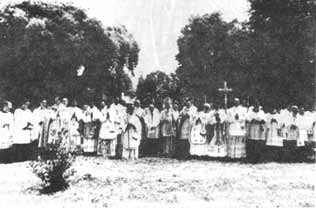
After the priestly ordinations. The eight new priests, including three Americans, can be seen left and right of the two bishops and Father Aulagnier.
